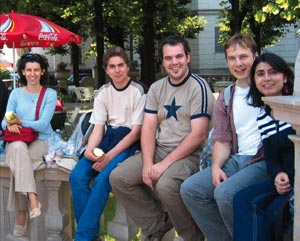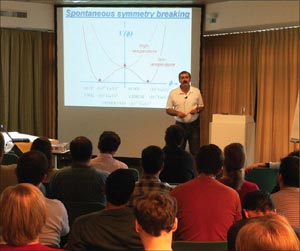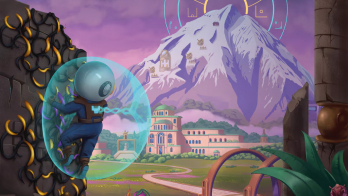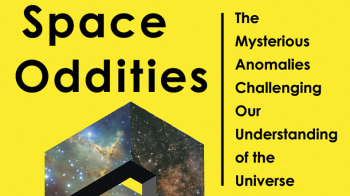Sezen Sekmen describes her experience as a student at the European School for High Energy Physics, which was hosted this year by Austria in the scenic town of Kitzbühel.
“Seventy per cent of today’s successful particle physicists have attended this school – which means you have a high chance to be one of them in the future,” says a joyful Egil Lillestøl as he welcomes us to the 2005 European School for High Energy Physics. Instantly more than 100 glasses rise, accompanied by a cheerful applause. We all feel lucky to be here.

We are in Kitzbühel, a peaceful town with green and beautiful surroundings in south-west Austria, to witness a curious learning experience and to contribute to its spirit as much as we can. The first evening’s dinner sweeps away any clouds of anxiety we might have, and observations of the first encounters have provided more than 5σ evidence of a great event.
On the first morning, just as rain is refreshing the beauty of the mountains outside, the overhead projector starts to light up the first fields and interactions on the screen. Wilfried Buchmüller from DESY provides us with the most fundamental piece of knowledge we will ever need – the Standard Model itself. The school’s academic programme is like a perfect PhD Student’s Guide to High-Energy Physics, as if to advise “don’t panic” in the wide and diverse realm of this exciting subject, “we will show you the route”.

Our appetite for learning grows as cosmology slowly makes peace with precision in the lectures by Rocky Kolb from Fermilab. He calmly strides through the whole universe, from its brilliant but furious past to its settled and gloomy present, from its simply overwhelming dark side to its modest but comforting light side.

Then enters Larry McLerran from Brookhaven, who introduces us to the colour glass condensate and the quark-gluon plasma, which happen to be two rather unusual forms of strongly interacting matter. He tells us the ancient tales of the good old days when quarks and gluons used to enjoy their freedom, and how the Relativistic Heavy Ion Collider came along at Brookhaven with the aim of capturing a few memories of such eras. On the other hand, Gerhard Ecker from Vienna draws a somewhat more familiar portrait of strong interactions as he systematically goes through quantum chromodynamics, explaining the usual quarks and gluons, and showing the remarkable detail hidden behind even the simplest approaches in this theory.
The evenings call for our creativity in the discussion sessions (which might also be considered as gentle warnings for us to stay awake during the lectures). Having received our daily lecture notes we are divided into six discussion groups, where we are supposed to make an account of the day’s learning and remove any obscurities in the lectures. Encouraged by the friendly attitudes of our discussion leaders, who are all young and willing theorists, and of the visiting lecturers, any shyness disappears and the first hints of inspiration begin to appear as ideas, questions and comments bravely make their way into the discussions.
It is now Thursday night and the poster session begins, transforming modest students into proud physicists who share the outcomes of their current research with great skill and enthusiasm. As well as discovering new ideas, we also see some different approaches to familiar subjects. For example, as someone who wrote an MSc thesis on the analysis of miniature black holes in the CMS experiment at CERN, I am delighted to come across a poster on a similar study for ATLAS. I discover that our friends from Oxford suffered the same problems we did, and so over discussions we decide to support each other in any future studies of these ruthless objects. Best of all though, is to have the vision that through all of these diverse contributions the goals of physics today can indeed be fulfilled.
The sound of music
But it’s not all work. We also have enough time to answer the irresistible call of the great Alps or to relax in the pleasant atmosphere of the historic town of Kitzbühel. On Saturday we visit Salzburg, the town enchanted by the graceful hand of Mozart.
The second week brings new lectures and new lecturers. After convincing us that Buchmüller’s Standard Model is fine but definitely insufficient, John Ellis from CERN goes on to reveal the vast worlds beyond, which are ruled by brilliant scientific imagination, with of course some rightful emphasis placed on the unavoidable elegance of supersymmetry. His presence is an invaluable gift, especially for me, as my current research happens to be on supersymmetric dark matter. Inspired by his lectures, as devoted experimentalists, we even go on a dangerous quest for dark matter on the nearby Schwarzsee at night.
Later, Robert Fleischer, also from CERN, explains how a nasty complex phase destroyed the beautiful CP symmetry and introduced some excitement into our universe, which would otherwise be less interesting; and how it also caused a few headaches among the physicists trying to explore the rich phenomenology of the Cabibbo-Kobayashi-Maskawa matrix and its unitarity triangles. We then discover some “CP violating terms” in the local organizing committee as two of its members from Vienna, Manfred Jeitler and Laurenz Widhalm, in addition to their efforts to offer us an outstanding experience, present lectures on experimental aspects of B- and K-physics, respectively. Then Manfred Lindner from Munich describes the ghostly neutrinos and the many consequences of their mischievous behaviour, and gives a long list of the global endeavours to discover their nature experimentally.
There are even some lectures not on particle physics. Wolfram Müller from Graz gives instructions on the physics of ski jumping, which seems quite appropriate in Kitzbühel, and Herbert Pietschmann from Vienna shows us our fate on the way to knowledge in his delightful lecture on physics and philosophy.
Meanwhile, the interactions increase, just as predicted by the famous “Summer Student Group Theory”. Although we have grown up under the strict hands of scientific work, the children within us still seek fun and adventure. We make the most of a colourful international community formed without prejudices and borders. The coffee breaks, which seemed a little long in the beginning, now fly swiftly by with cheerful conversations. I feel a significant improvement in my debating skills, especially after all the “SUSY and beyond” discussions with several expert theorist friends.
Grand finale
However, the inescapable end is close. In order to avoid becoming too melancholy and to create a glorious finale, we amalgamate all our creativity in preparing an unforgettable farewell night. This time we are on stage, giving so-called lectures on “serious subjects” (that cannot be mentioned here!), singing, acting and doing all sorts of things to entertain our audience. But finally we have to say difficult goodbyes to all of our friends (yes, we are friends now), and leave the cosy Hotel Kitzhof, where our hosts, through their patience and goodness, have somehow managed to survive our two-week occupation.
I know that all of us share the same feeling of gratitude towards everyone who made this school possible. I am especially indebted, as a student coming from an observer state who had the privilege of being supported through the generosity of CERN. We are greatly thankful for the endless support and kindness we received from Egil Lillestøl (CERN schools director), Danielle Métral (CERN schools secretary), Tatyana Donskova (JINR schools secretary), all the local organizers plus all the other representatives of CERN and JINR who were with us during the school. We have been thoroughly enriched as a result of their sincere efforts. This worthy tradition must continue, as long as physics has new puzzles to offer us and as long as we can respond through willing fresh minds.







